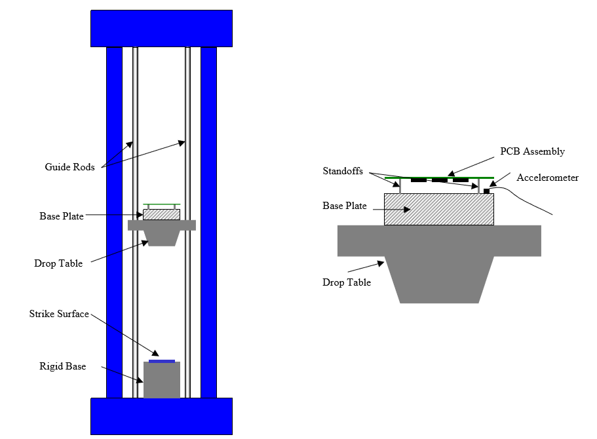Tldr: Shaking your electronics is bad. After awhile, they tend to break. Simulation can predict how long electronics last, but there are many decisions to be made. You need to understand the type of vibration and what components you are most concerned with in order to use simulation effectively.

Vibration analysis can be a bit complicated, but hopefully this article will help.
Continuing on to the 2nd most common cause of failure in electronics… Vibrations.
This is the shaky stuff, like dropping your phone, attaching your computer to the chassis of a car or mounting it on a motor.
Finding out your device is susceptible to vibration damage during testing sucks. Because, by then, you have the entire system designed and even a prototype built. Now you need to go back and figure out how to make it stronger/lighter/both.
Fortunately there is a long history of simulating vibrations to prevent failure, much of which can be applied to electronics.
The Framework
To start, we need to define the types of vibrations that are worrisome.
-
Sinusoidal - electronics mounted on a motor that operates at a constant speed.
-
Drop/impact - cell phone falling on a floor
-
Random vibrations - electronics mounted on a car or airplane
Then we need to determine the type of component of interest.
-
Large brackets and support structures (metal/big pieces of plastic)
-
Energy absorbing structures (crumple zone/rubber bumpers)
-
Electronics components (delicate chips, connectors, pcb)
In simulation, we have 2 types of solution options.
-
Linear dynamics - fast and always preferred
-
Nonlinear dynamics - slow and to be avoided unless you have no choice
Finally we need to characterize damping to ensure the magnitude of the response is correct.
That’s a lot to think about! … and that’s why I wrote up this guide.
Let’s get started with the components of interest
Fatigue failure is almost always too small to simulate explicitly. So anytime we are talking about simulation of durability, we are actually talking about finding good correlations between durability tests and some variable in an FEA simulation.
Durability of large structural parts (cases, brackets, housing etc) are calculated using SN/EN data like they did in the 1900’s (stress or strain vs cycles to failure)
If you want to get fancy, you can use fracture mechanics methods like they do at cool aerospace companies!
Energy absorbing structures typically deform a great deal; think car crash or cellphone case drop. This requires explicit nonlinear dynamics tools and some careful setup. It is done regularly at all major consumer electronics and automotive companies.
Electronics components are pretty fragile, so deflections of interest is pretty small and only linear analysis is needed. However, they are extremely complex geometrically.
Detailed simulation is not an option, but luckily lots of research has been done to characterize the durability of different components. Works like “Dave S. Steinberg, Vibration Analysis for Electronic Equipment” and others found correlations between the PCB deformation during vibration and time to failure for a wide range of components. With the proper tools to automate the process, the time to failure of a complete board can be evaluated pretty efficiently these days.
Types of loading
Harmonic
Sinusoidal/harmonic loading is the most basic durability analysis. Simulation will predict the deformation and stress for a single frequency or a sweep across many frequencies. From there, it is a simple matter of checking with a SN curve to predict the time to failure.
Drop and impact

This is a typical setup for JEDEC specified component level drop test. Note the strike surface needs to be carefully calibrated to get the right shock function. This is a much easier task in simulation.
For energy absorbing structures, an explicit dynamics analysis is required.
However for many electronics components, there are multiple options.
Response spectrum analysis is a frequency domain linear shock simulation method that predicts the maximum deformation and stress during a shock event. This is good for predicting failure and response rather than durability.
Modal superposition transient simulation is a linear transient dynamic simulation. This provides a full time history of deformation and stress so it can be used to predict durability. It requires an input of shock history in the time domain.
Explicit transient dynamics can model an entire device, including energy absorbing structures. However, this is computationally expensive and requires careful setup for large assemblies.
Random Vibrations
Random vibrations require a power spectrum density (PSD) input of the vibration load. It is a frequency domain linear dynamics analysis so it’s valid for electronics mounted on chassis or electronics during shipping. Because random vibration can be used to calculate stress and deformation probabilities at various frequencies, it is a handy tool for reliability calculations of electronics components and various other structures under long duration vibration loading.
A little on damping
For reliability simulations, we need accurate motion and stress of the system.

Damping is frequency dependent. However, there is an range of frequencies where the damping is typically fairly stable.
Damping plays a significant role and it needs to be tuned. Depending on the type of mounting conditions, the damping ratio of a PCB can be between 2% to 10%. A typical validation is to take a PCB with a realistic mounting system, subject it to a vibrations test to measure the max displacement around the frequency of interest, then calculate the damping from this data.
Wrap it up
Vibration is a complicated problem because it often involves the entire electronics assembly, and the simulations are time consuming. This has resulted in many different methods to simplify the problem where possible.
Hopefully this gives you some structure in understanding what we do during a vibration durability simulation. If you have a real problem, feel free to reach out to us.
Remember to smash the like button and share this with your friends!
Dec 26, 2018 3:30:59 PM
